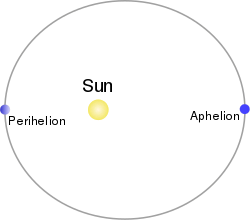Perihelion and aphelion
The perihelion (/ˌpɛrɪˈhiːliən/) of any orbit of a celestial body about the Sun is the point where the body comes closest to the Sun. It is the opposite of aphelion (/æpˈhiːliən/), which is the point in the orbit where the celestial body is farthest from the Sun.[1]
Etymology
The words perihelion and aphelion were coined by Johannes Kepler[2] to describe the orbital motion of the planets. The words are formed from the prefixes peri- (Greek: περί, near) and apo- (Greek: ἀπό, away from) affixed to the Greek word for the sun, ἥλιος.[3]
Perihelion and aphelion are sometimes incorrectly used for the orbits of objects about bodies other than the Sun. The correct terms are:
- For orbits around the Earth: perigee and apogee.
- For orbits around a star: periastron and apastron.
- For orbits around any center of mass: periapsis (or pericenter) and apoapsis (or apocenter).
Astronomical meaning
According to Kepler's first law of planetary motion, all planets, comets, and asteroids in the Solar System have approximately elliptical orbits around the Sun.[4] Newton's and Einstein's laws of gravity imply that the orbits are only approximately elliptical because of perturbations due to the gravitational attraction of other bodies. Every ellipse has two focus points, and the Sun is at one of these focus points for the elliptical orbits of its satellites. Hence, an orbiting body has a closest and a farthest point from its parent object, that is, a perihelion and an aphelion. Each extreme is known as an apsis.
Orbital eccentricity measures the flatness (departure from a perfect circle) of the orbit.
Application to Earth
Earth is about 147.1 million kilometers (91.4 million miles) from the Sun at perihelion around January 3, in contrast to about 152.1 million kilometers (94.5 million miles) at aphelion around July 4 — a difference of about 5.0 million kilometers (3.1 million miles). (These dates change over time due to precession and other orbital factors, which follow cyclical patterns known as Milankovitch cycles. For a table of these dates for various years, see Apsis.)
Because of the increased distance at aphelion, only 93.55% of the solar radiation from the Sun falls on a given area of land as does at perihelion. However, this fluctuation does not account for the seasons,[5] as it is summer in the northern hemisphere when it is winter in the southern hemisphere and vice versa. Instead, seasons result from the tilt of Earth's axis, which is 23.4 degrees away from perpendicular to the plane of Earth's orbit around the sun. Winter falls on the hemisphere where sunlight strikes least directly, and summer falls where sunlight strikes most directly, regardless of the Earth's distance from the Sun.
In the northern hemisphere, summer occurs at the same time as aphelion. Despite this, there are larger land masses in the northern hemisphere, which are easier to heat than the seas. Consequently, summers are 2.3 °C (4 °F) warmer in the northern hemisphere than in the southern hemisphere under similar conditions.[6]
See also
References
- ↑ Walker, Peter, ed. (1988). Cambridge Dictionary of Science and Technology (Hardback)
|format=requires|url=(help). Cambridge, England: Cambridge University Press. pp. 44, 660. ISBN 0-521-39441-4. - ↑ Klein, Ernest, A Comprehensive Etymological Dictionary of the English Language, Elsevier, Amsterdam, 1965. (Archived version)
- ↑ Since the Sun, Ἥλιος in Greek, begins with a vowel, H is the long e vowel in Greek, the final o in "apo" is omitted from the prefix. The pronunciation "Ap-helion" is given in many dictionaries , pronouncing the "p" and "h" in separate syllables. However, the pronunciation /əˈfiːliən/ is also common (e.g., McGraw Hill Dictionary of Scientific and Technical Terms, 5th edition, 1994, p. 114), since in late Greek, 'p' from ἀπό followed by the 'h' from ἥλιος becomes phi; thus, the Greek word is αφήλιον. (see, for example, Walker, John, A Key to the Classical Pronunciation of Greek, Latin, and Scripture Proper Names, Townsend Young 1859 , page 26.) Many dictionaries give both pronunciations
- ↑ "Introductory Astronomy: Ellipses". Washington State University.
- ↑ "Solar System Exploration: Science & Technology: Science Features: Weather, Weather, Everywhere?". NASA. Retrieved 2015-09-19.
- ↑ "Earth at Aphelion". Space Weather. July 2008. Retrieved 7 July 2015.
External links
- Dates and times of Earth's perihelion and aphelion, 2000–2025 from the United States Naval Observatory
- List of asteroids currently closer to the Sun than Mercury (These objects will be close to perihelion)
